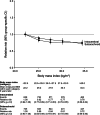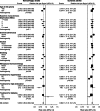Adiposity and ischemic and hemorrhagic stroke: Prospective study in women and meta-analysis
- PMID: 27605176
- PMCID: PMC5075975
- DOI: 10.1212/WNL.0000000000003171
Adiposity and ischemic and hemorrhagic stroke: Prospective study in women and meta-analysis
Abstract
Objective: To compare associations of body mass index (BMI) with ischemic stroke and hemorrhagic stroke risk, and to review the worldwide evidence.
Methods: We recruited 1.3 million previously stroke-free UK women between 1996 and 2001 (mean age 57 years [SD 5]) and followed them by record linkage for hospital admissions and deaths. We used Cox regression to estimate adjusted relative risks for ischemic and hemorrhagic (intracerebral or subarachnoid hemorrhage) stroke in relation to BMI. We conducted a meta-analysis of published findings from prospective studies on these associations.
Results: During an average follow-up of 11.7 years, there were 20,549 first strokes, of which 9,993 were specified as ischemic and 5,852 as hemorrhagic. Increased BMI was associated with an increased risk of ischemic stroke (relative risk 1.21 per 5 kg/m2 BMI, 95% confidence interval 1.18-1.23, p < 0.0001) but a decreased risk of hemorrhagic stroke (relative risk 0.89 per 5 kg/m2 BMI, 0.86-0.92, p < 0.0001). The BMI-associated trends for ischemic and hemorrhagic stroke were significantly different (heterogeneity: p < 0.0001) but were not significantly different for intracerebral hemorrhage (n = 2,790) and subarachnoid hemorrhage (n = 3,062) (heterogeneity: p = 0.5). Published data from prospective studies showed consistently greater BMI-associated relative risks for ischemic than hemorrhagic stroke with most evidence (prior to this study) coming from Asian populations.
Conclusions: In UK women, higher BMI is associated with increased risk of ischemic stroke but decreased risk of hemorrhagic stroke. The totality of the available published evidence suggests that BMI-associated risks are greater for ischemic than for hemorrhagic stroke.
© 2016 American Academy of Neurology.
Figures




Comment in
-
Body mass index and stroke in UK women: "Obesity paradox" revisited.Neurology. 2016 Oct 4;87(14):1432-1433. doi: 10.1212/WNL.0000000000003186. Epub 2016 Sep 7. Neurology. 2016. PMID: 27605174 No abstract available.
References
-
- Goldstein LB, Bushnell CD, Adams RJ, et al. . Guidelines for the primary prevention of stroke: a guideline for healthcare professionals from the American Heart Association/American Stroke Association. Stroke 2011;42:517–584. - PubMed
Publication types
MeSH terms
Grants and funding
LinkOut - more resources
Full Text Sources
Other Literature Sources
Medical
